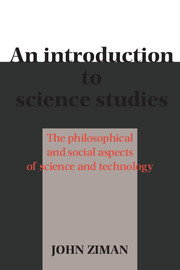Book contents
- Frontmatter
- Contents
- Preface
- 1 ‘Academic’ science
- 2 Research
- 3 Validity
- 4 Communication
- 5 Authority
- 6 Rules and norms
- 7 Change
- 8 The sociology of scientific knowledge
- 9 Science and technology
- 10 Pure and applied science
- 11 Collectivized science
- 12 R & D organizations
- 13 The economics of research
- 14 Science and the State
- 15 The scientist in society
- 16 Science as a cultural resource
- Index
13 - The economics of research
Published online by Cambridge University Press: 05 August 2012
- Frontmatter
- Contents
- Preface
- 1 ‘Academic’ science
- 2 Research
- 3 Validity
- 4 Communication
- 5 Authority
- 6 Rules and norms
- 7 Change
- 8 The sociology of scientific knowledge
- 9 Science and technology
- 10 Pure and applied science
- 11 Collectivized science
- 12 R & D organizations
- 13 The economics of research
- 14 Science and the State
- 15 The scientist in society
- 16 Science as a cultural resource
- Index
Summary
‘The story is told that Sir Robert Peel, the Prime Minister, visited Faraday in the laboratory of the Royal Institution soon after the invention of the dynamo. Pointing to this odd machine, he inquired of what use it was. Faraday is said to have replied “I know not, but I wager that one day your government will tax it”.’
L. Pearce Williams (in Michael Faraday, London: Chapman & Hall, 1965)Costing the benefits
The purpose of R & D is to provide benefits. But how should the value of these benefits be assessed? It is all very well to say that research on insecticides has resulted in improved crops of bananas, but was the improvement worth the cost of the research? Research costs real money and its outcome is very uncertain. It might have been more profitable to invest the money in a new plantation. Without some rough estimate of the relative balance of costs and benefits, the use of science as an instrument of policy (§12.1) is based solely on blind faith.
The inputs to R & D can easily be quantified in money terms. The cost of employing researchers and providing them with suitable apparatus, buildings, technical staff, telephones, travel to conferences, and so on would normally appear as line items in the financial accounts of the corporation or agency supporting the laboratory.
- Type
- Chapter
- Information
- An Introduction to Science StudiesThe Philosophical and Social Aspects of Science and Technology, pp. 149 - 158Publisher: Cambridge University PressPrint publication year: 1984



